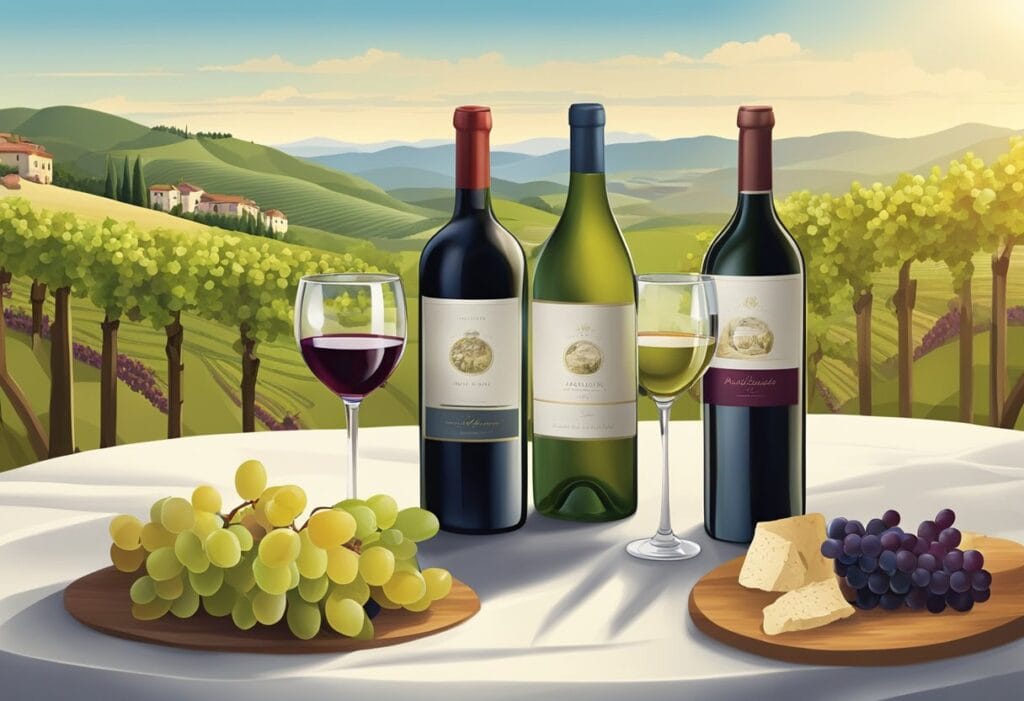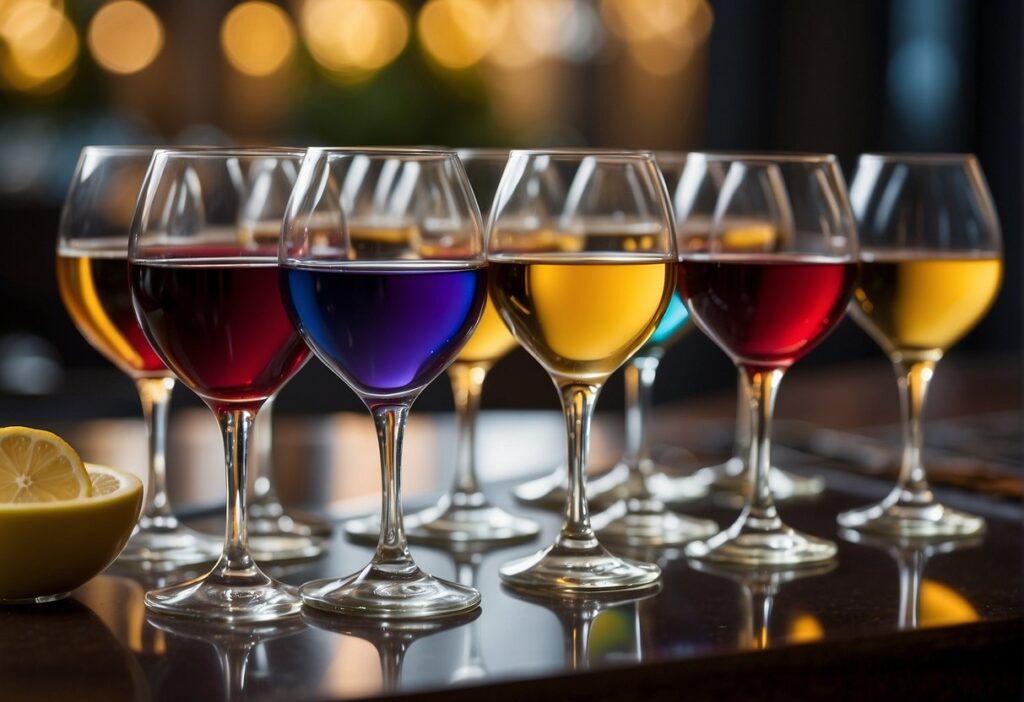White wine offers an array of flavors, aromas, and experiences, making it a favorite among both casual drinkers and connoisseurs. You can choose from a spectrum of types, each with its own unique profile and suitability for different occasions.
From the crisp acidity of a Sauvignon Blanc to the buttery richness of a Chardonnay, white wines are as versatile as they are enjoyable.
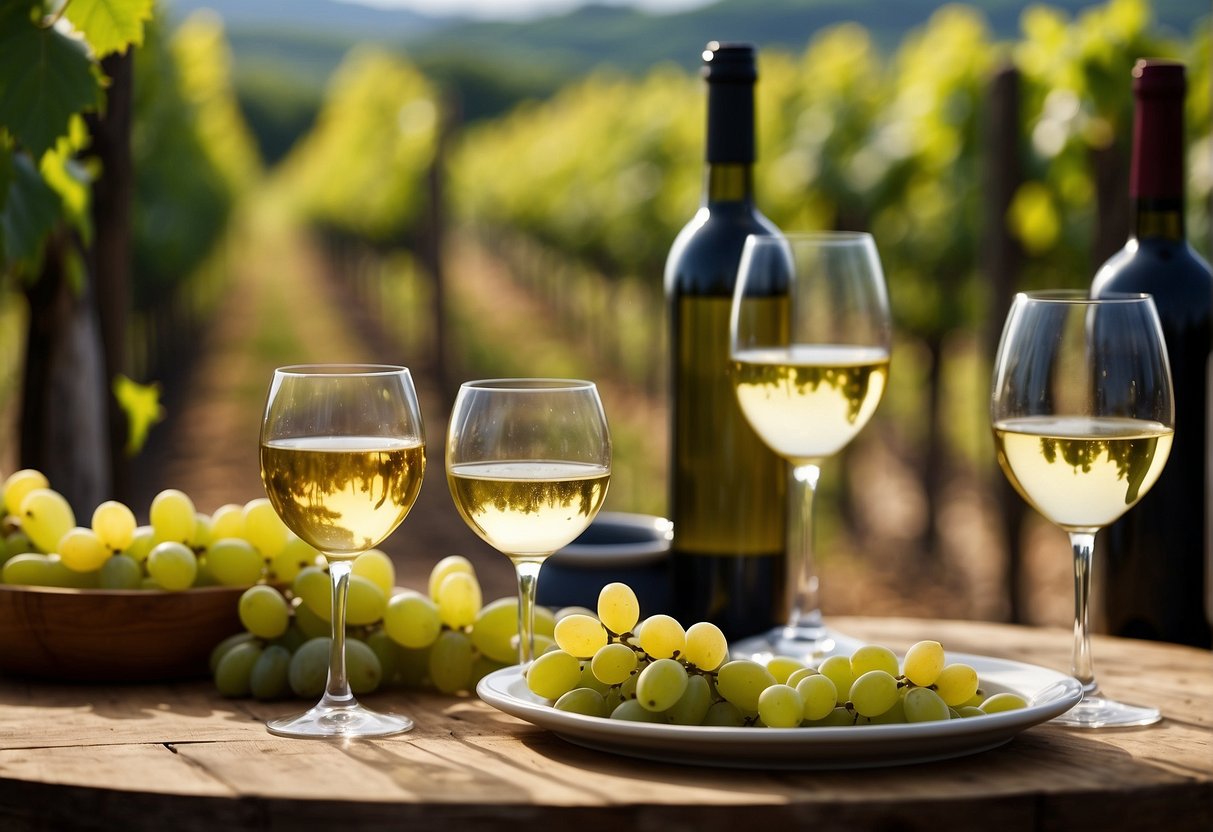
Understanding white wine begins with recognizing the major grape varieties and their characteristics.
White wines can range from light and zesty to rich and full-bodied, influenced by the grape’s region and the winemaking process.
Exploring white wine varietals includes tasting the different flavors and learning about the importance of terroir—the climate, soil, and geography that give wine its distinctive character.
As you expand your knowledge and palate, you’ll appreciate the nuances in pairing food with white wine, the intricacies of white wine production and aging, and the sustainable practices in white wine production.
Serving and enjoying white wine enhances the experience, and there’s an exciting world of regional white wines to discover.
Key Takeaways
- White wines vary from crisp and light to rich and full-bodied.
- Pairing and serving white wine enhances its enjoyment.
- The production and regional characteristics of white wine influence its flavor profile.
Understanding White Wine
When you explore white wine, you’re delving into a diverse world of flavors and styles shaped by various grape varieties.
Each type offers a unique taste and flavor profile that ranges from dry to sweet, and from crisp to creamy.
- Dry white wines, such as Sauvignon Blanc or Pinot Grigio, typically possess a sharp acidity and fresh, citrus notes, perfect for those who seek a zesty refreshment.
- Sweet varieties, like Riesling and Moscato, offer a luscious palate with hints of fruits and sometimes floral tones.
- For a creamy texture and rich flavor, you might enjoy an oaked Chardonnay, which spends time maturing in oak barrels.
Visually, you might be familiar with the classic pale gold or straw color, but some types can exhibit a deeper yellow or even greenish hue.
Lesser-known varieties often surprise with distinct notes such as spice, floral, or minerality, adding to the tapestry of tastes available to you.
- Unoaked wines typically showcase the grape’s pure expression with a sharper acidity and minerality.
- In contrast, oaked wines often reveal a smoother character with a subtle vanilla or toasty flavor.
White wines offer you an exquisite variety of options:
| Style | Description | Grape Varieties |
|---|---|---|
| Crisp | Fresh & acidic | Sauvignon Blanc |
| Sweet | Fruity & fragrant | Riesling |
| Creamy | Rich & buttery | Oaked Chardonnay |
Your personal preference may lean towards a light and crisp Pinot Grigio or the complexity of a creamy, oaked white. Regardless of your taste, there’s a white wine that’s sure to delight your palate.
Major White Wine Varieties
When you explore the world of white wines, you’ll discover the distinct personalities of each variety.
Chardonnay
Chardonnay, often associated with flavors of apple and citrus, can vastly differ based on whether it’s aged in oak barrels or not.
Aging in oak may impart a buttery richness, iconic of many wines from Burgundy and Chablis, while unoaked Chardonnay maintains a cleaner, crisper profile.
Sauvignon Blanc
Your next glass of Sauvignon Blanc might surprise you with its crisp nature and citrus or green apple notes.
This herbaceous wine, hailing from the Loire Valley or the refreshing regions of New Zealand, is ideal for those who enjoy a zesty, vivacious sip.
Riesling
Venture into the sweeter or the driest renditions of Riesling, and you’ll be greeted by a bouquet of floral and stone fruit aromas.
Whether it’s from Germany, Alsace, or elsewhere, Riesling’s versatility can present an aromatic and sometimes spicy drink that’s highly aromatic and packed with character.
Major White Wine Varieties
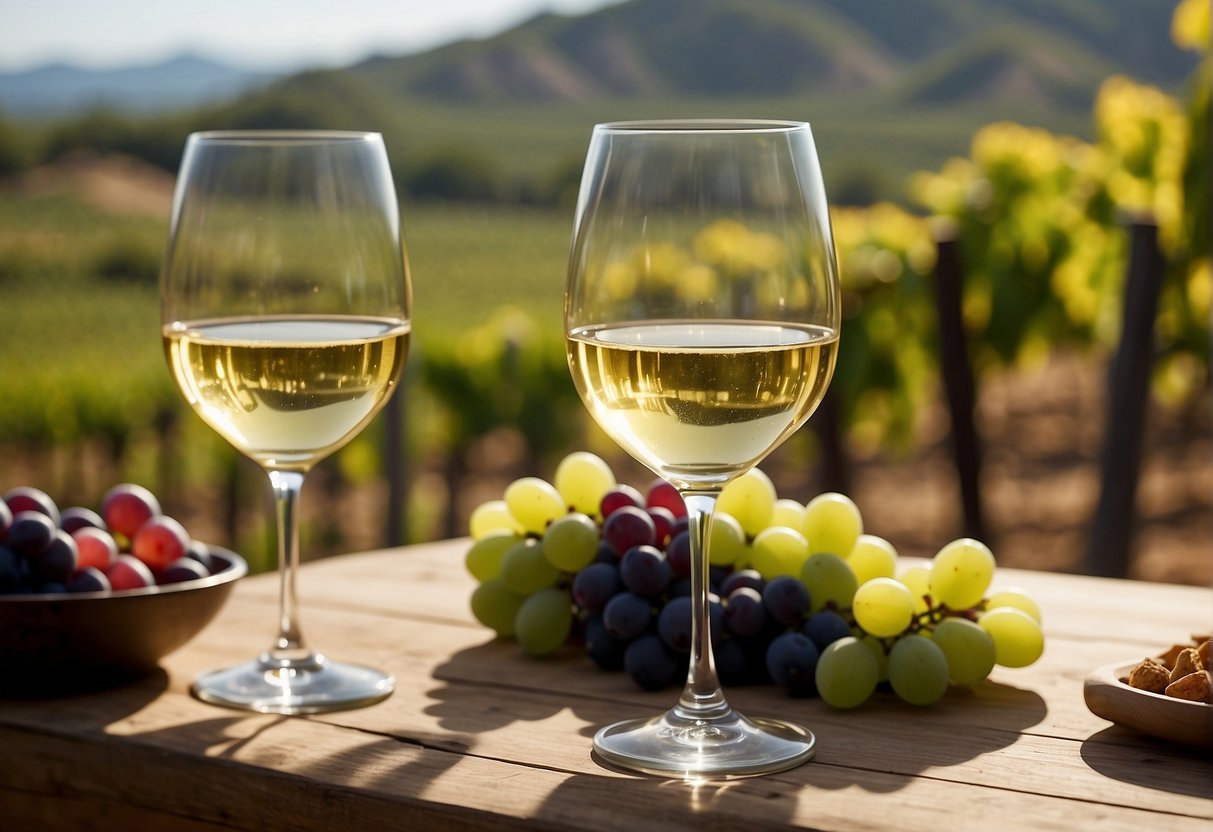
In the diverse world of white wines, you’ll encounter distinct flavors ranging from sweet and floral to crisp and herbaceous. Here’s an overview of three major white wine varieties that are beloved for their unique characteristics and food pairing capabilities.
Gewürztraminer
Gewürztraminer is known for its aromatic and spicy profile, often boasting a floral aroma that can include hints of rose petals, alongside lychee and other stone fruit.
Originating from the Alsace region, this variety creates wines that can vary from dry to sweet, but they always retain a strong personality that makes them unforgettable when paired with rich, spicy foods.
Pinot Gris/Pinot Grigio
This grape results in two wines that share a name but can offer different experiences.
Pinot Gris, typically from France, tends to be full-bodied and rich, with flavors of ripe stone fruits.
In contrast, Pinot Grigio, with its roots in Italy, is often lighter, presenting a crisp and fruity profile.
Both are excellent companions for seafood and are appreciated for their refreshingly high acidity.
Viognier
Viognier is a white wine that is both powerful and elegant, featuring a floral bouquet with prominent notes of apricot and peach.
It’s a full-bodied wine, often aged in oak barrels, which contributes to a creamy texture.
With its roots in the Hermitage region of France, Viognier matches well with dishes that are aromatic and rich, such as roasted chicken with herbed butter or creamy seafood pastas.
Major White Wine Varieties

As you explore the diverse world of white wines, you’ll discover that each variety offers a unique taste profile, ranging from sweet and fruity to dry and crisp. Let’s dive into some of the whites that you’re likely to encounter on this flavorful journey.
Chenin Blanc
Chenin Blanc is a versatile white wine that hails from the Loire Valley but has made a home for itself in South Africa.
You’ll find that it can vary from sweet to dry, often exhibiting flavors of apple, citrus, and hints of floral notes.
Its ability to age in oak barrels results in buttery textures akin to Chardonnay.
Moscato
Often seen as the go-to for sweet wine lovers, Moscato, also known as Muscat Blanc, is fruity and floral, coming primarily from Italy.
It’s widely enjoyed as a dessert wine and pairs splendidly with light pastries and fruits.
Think of it as sipping on a glass of stone fruit and citrus wrapped in a floral aroma.
Other Notable Whites
- Chardonnay: This popular wine can go from lean and mineral in Chablis, France, to full-bodied and creamy when aged in oak barrels. You’ll often taste notes of apple, citrus, and even butter.
- Sauvignon Blanc: Known for its crisp and herbaceous character, it brings the green apple and citrus to your palate, with notable regions including the Loire Valley and New Zealand.
- Riesling: Hailing from Germany and Alsace, it ranges from dry to very sweet, offering a floral and often fruity bouquet of aromas.
- Gewürztraminer: Another gem from Alsace, this aromatic wine is loved for its spicy and floral aroma, often suggesting hints of lychee.
- Pinot Gris/Pinot Grigio: Whether from Italy or France, this grape offers a fruity and crisp wine experience, with some versions leaning towards a fuller body.
- Viognier: Often found in the Hermitage region of France, Viognier is a full-bodied wine with strong floral notes and a palate of apricot and sometimes even a creamy texture.
Regional White Wines

Discover the hallmark white wines that define some of the world’s most renowned wine regions. Each area offers distinctive flavors and styles shaped by local grape varieties, climate, and winemaking traditions.
French Whites
In France, Chardonnay and Sauvignon Blanc stand out with unique expressions in regions like Burgundy, Alsace, Loire Valley, and Bordeaux. For example, Burgundy is famous for its complex and elegant Chablis, a testament to the Chardonnay grape’s versatility. Meanwhile, the Loire Valley showcases vivacious Sauvignon Blanc wines, noted for their crisp acidity and mineral undertones.
Italian Whites
Italy celebrates a diversity of white wines, featuring varieties such as Pinot Grigio (also known as Pinot Gris), Moscato, and Vermentino. The light and crisp Pinot Grigio is a refreshing choice, often enjoyed for its citrusy zest. Meanwhile, sweet and fragrant Moscato hails from the northern regions, and Vermentino offers a herbal and peachy profile typically found along the coast.
German and Austrian Whites
Germany and Austria shine with their aromatic white wines like Riesling, Gewürztraminer, and Grüner Veltliner. Riesling from Germany ranges from bone-dry to lusciously sweet, all with a racy acidity and often slate-driven minerality. Meanwhile, Austria’s star grape, Grüner Veltliner, gives peppery and zesty wines that are gaining recognition worldwide.
New World Whites
The New World, encompassing regions like California, Australia, New Zealand, Argentina, and Chile, produces vibrant Sauvignon Blanc and rich Chardonnay. California’s Chardonnay might be bold and buttery, while Sauvignon Blanc from New Zealand is famous for its intense aromatics and lively fruit flavors. These regions enjoy innovative winemaking techniques that often result in groundbreaking styles.
Pairing Food with White Wine

When you’re pairing food with white wine, your goal is to complement the flavors in both the wine and the meal. White wines come in a variety of styles, from crisp and dry to sweet and fruity. Understanding the profile of the wine you have will guide you to the perfect food pairing.
Seafood is a classic match for white wine, especially lighter varieties like Sauvignon Blanc or Pinot Grigio. Consider enjoying a glass with grilled shrimp or a fresh seafood salad. The wine’s acidity mirrors the seafood’s briny flavors and the light body doesn’t overpower the dish.
For meat dishes like pork or turkey, opt for a Chardonnay with a bit of oak to it. This richer white wine can stand up to the meat’s heft while providing a pleasing contrast to the savory flavors. Roast chicken, complemented by white wines with lemon or lime notes, highlights both the dish and the wine.
A crisp Riesling pairs excellently with spicy foods. Its slight sweetness can cool the heat, making it an excellent choice for spicy Thai or Indian cuisine.
When your meal features fruits like apple, pear, peach, or mango, a Gewürztraminer with its tropical and floral notes will work wonders. This off-dry white wine brings out the fruitiness in your dish while maintaining a refreshing balance.
| Wine Type | Food Pairing | Flavor Notes |
|---|---|---|
| Sauvignon Blanc | Grilled Seafood, Green Salads | Crisp, Citrusy |
| Chardonnay | Roast Turkey, Creamy Pasta | Rich, Oaky |
| Riesling | Spicy Dishes, Tangy Salads | Sweet, Refreshing |
| Gewürztraminer | Fruit Salads, Mild Asian Cuisine | Tropical, Floral |
White Wine Production and Aging

When you explore the fascinating world of white wine production, you’ll find that vinification — the process of making white wine — requires careful attention and precision. Here are the steps that turn grapes into the white wines you love.
Vinification
First, grapes are harvested and swiftly transferred to the winery to start production. Winemakers decide whether to ferment the wine with or without the grape skins, depending on the desired wine style.
Fermentation
Then comes the fermentation phase. Yeasts convert the sugars in the grape juice into alcohol, and this can happen in various vessels. Typically, white wines are fermented in either stainless steel tanks, which promote a crisp, fresh character, or in oak barrels, which impart richer flavors and complexity.
Aging
After fermentation, the wine might undergo aging. While many white wines are enjoyed young and are unoaked, others benefit from time spent in barrels. Oak aging adds nuances of vanilla and spice, and it’s not just about where it’s aged but for how long.
- Unoaked: Wines are bottled shortly after fermentation to preserve their zesty freshness.
- Oaked: Wines spend months to years in barrels developing deeper flavors.
Remember, not all white wines are meant for extensive aging. Most are best enjoyed within a few years of production, but some, like a quality Chardonnay or Sémillon, can improve with age. These wines, often produced with lower pH levels, gain complexity and aromatic depth over time.
Serving and Enjoying White Wine

When you’re ready to enjoy a glass of white wine, the temperature at which you serve it can greatly affect its taste. For your lighter white wines, like Sauvignon Blanc or Pinot Grigio, aim to serve them chilled between 45-50°F (7-10°C). This helps maintain their crisp and refreshing quality. For fuller-bodied whites, such as Chardonnay, a slightly warmer temperature of 50-55°F (10-13°C) allows the complexity of flavors to shine.
Choosing the right glassware is also key to maximizing your enjoyment. Typically, white wines are served in narrower glasses, which help to maintain cooler temperatures and concentrate the aromas. When you pour, fill the glass only to about one-third to prevent the wine from warming up too quickly in your hand.
For those special occasions, you might choose a dessert wine or an aperitif. Dessert wines, served in smaller glasses, are sweeter and often enjoyed with or as a replacement for dessert, while an aperitif is usually dry and served before a meal to stimulate the appetite.
Exploring White Wine Varietals

When you start your journey into the world of white wines, you’ll discover a delightful range of varietals—each with its own unique profile. A varietal refers to the type of grape used and often gives the wine its name.
- Dry White Wine: This refers to wines with no residual sugar, resulting in no sweetness.
- Notable dry white wines include:
- Sauvignon Blanc: A crisp and refreshing choice, with zesty citrus flavors.
- Chardonnay: Offers a spectrum from light and fruity to rich buttery tastes.
Italics are used for wine names to highlight their unique identity and aid your selection process.
- Sweet White Wine: These wines contain higher levels of residual sugar and can range from lightly sweet to dessert-level sweetness.
- Some notable sweet white wines include:
- Riesling: Typically sweet, but you can find off-dry (semi-sweet) variants that are more subtle in their sweetness.
- Moscato: Known for its sweet floral aromas, often a favorite for those who prefer a sweeter sip.
As you explore, consider the balance of sweetness and acidity. Some white varietals may surprise you with how they straddle these elements.
- Off-Dry: This term is often used to describe wines that have a slight hint of sweetness. These are a great middle ground if you’re unsure about going fully dry or sweet.
The Importance of Terroir in White Wine
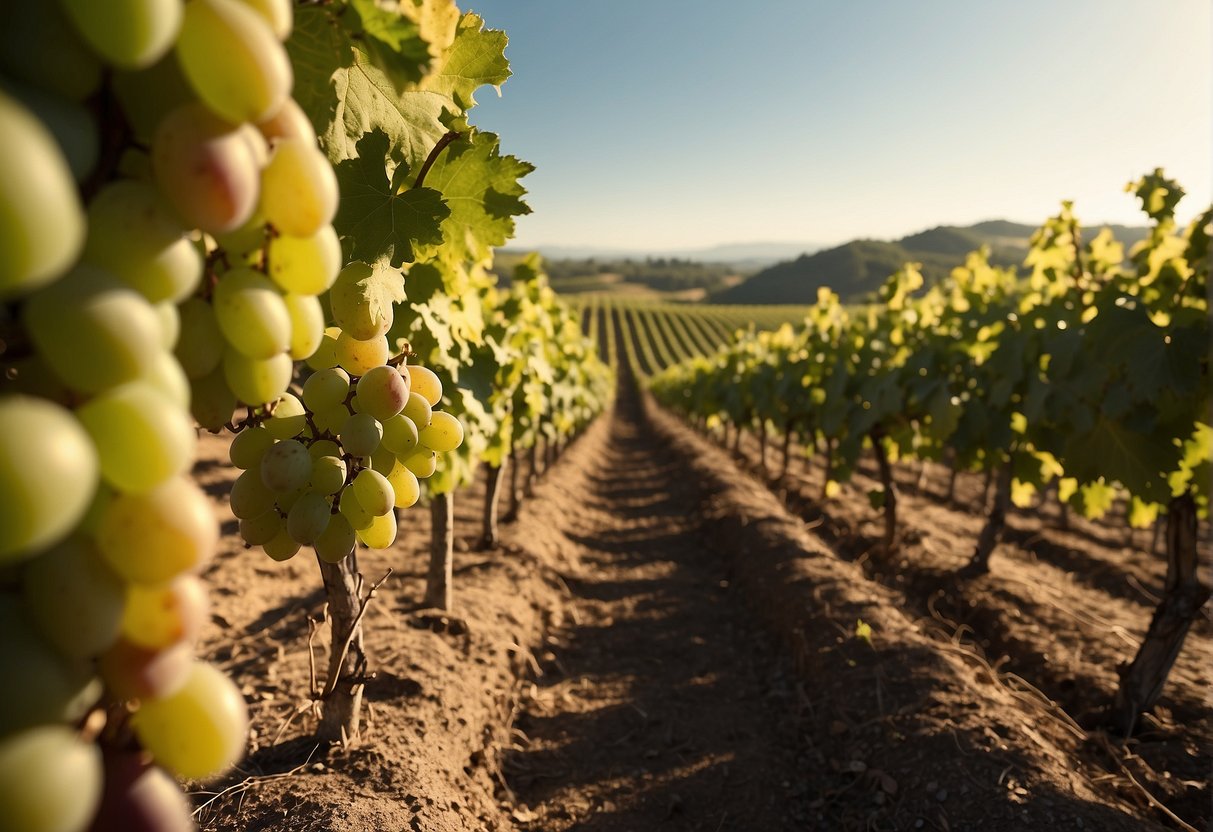
When you explore the diverse world of white wines, understanding terroir is crucial. Terroir is the environment in which a wine is produced, including factors such as soil type, climate, and elevation, all of which can significantly influence the flavor and quality of wine.
Consider the soil type: it’s more than just dirt.
Mineral-rich soils, for instance, can impart a flinty note to your Chardonnay, while chalky soils may produce a Chablis with remarkable crispness and vitality.
Climate plays an equally important role.
White wines from cooler regions, such as a Riesling from Germany, tend to have higher acidity and fresh fruit flavors.
Conversely, the same grape grown in a warmer climate might present riper fruit notes and less acidity, leading to a dramatically different tasting experience.
Then there’s the aspect of elevation.
At high altitudes, despite being closer to the sun, the temperature drops, forcing grapes to retain acidity. This is why you might find a Sauvignon Blanc from a high vineyard to be zestier compared to one grown at lower elevations.
White Wine in the Global Market

When you explore the global market for white wines, you’ll find a diverse landscape of both traditional and emerging wine regions. The consumption of white wine spans across continents, with varying preferences influencing import and export dynamics.
The most popular types of white wine globally include Chardonnay, Sauvignon Blanc, and Pinot Grigio, among others.
These wines are loved for their versatility and range from dry to sweet, catering to a broad audience. White Wine Market Size, Trends & Growth Analysis Report 2023 details the preference for different body types—light, medium, or full-bodied—and sweetness levels—from dry to sweet—across regions.
You’ll notice that trends in the white wine sector often reflect a growing interest in health-conscious and sustainable practices.
Consumers are increasingly leaning towards wines that align with their values, supporting producers that prioritize eco-friendly methods.
While discussing exports and imports, it’s important to recognize that some countries are renowned for their white wine production, such as France, Italy, and Spain.
These countries not only enjoy significant domestic consumption but also contribute greatly to the global presence of white wine, often driving consumer preferences in other countries as well.
Interestingly, figures from White Wine Global Market Report 2024 illustrate a trajectory of growth for the white wine market, suggesting that your appreciation for a nice glass of white may be shared by more people around the world than ever before.
Sustainable Practices in White Wine Production

In the wine world, sustainability has become a crucial aspect of white wine production. Vineyards are adopting environmentally friendly practices to ensure the land remains fertile and healthy for generations to come. Here’s how they’re making a difference:
Organic Viticulture: You might be familiar with organic foods, but did you know about organic viticulture? This approach avoids synthetic pesticides and fertilizers, focusing on natural alternatives to maintain vine health. It’s a step towards a healthier ecosystem and, many argue, a finer taste in your glass.
Biodynamic Methods: Going beyond the organic philosophy, biodynamic vintners use preparations made from herbs, minerals, and manure for composting and plant treatments. These practices consider the vineyard as a holistic organism, with biodynamic methods that align with the earth’s natural rhythms.
| Sustainable Efforts | Impact on Vineyard |
|---|---|
| Water conservation | Reduces waste and preserves local aquifers |
| Renewable energy | Lowers carbon footprint of wine production |
| Biodiverse habitats | Encourages a balanced ecosystem |
Energy and Water Efficiency: By implementing cutting-edge technology and age-old wisdom, vineyards can dramatically reduce their water usage and energy consumption.
Some vineyards harness solar power to run their operations. This not only saves energy but also secures a greener future for the wine industry.
Your choice to support vineyards engaged in sustainable practices helps promote a healthier planet and ensures the longevity of the winemaking tradition.
